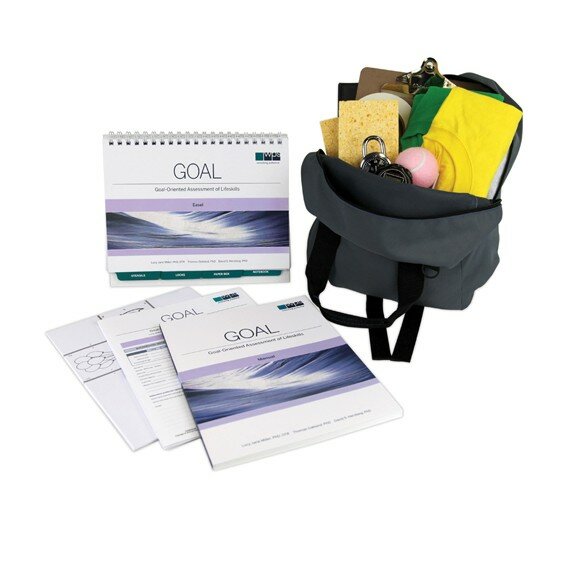Please specify the quantity of product(s).



Goal-Oriented Assessment of Lifeskills (GOAL)
| Item | Product | Price | QTY |
|---|---|---|---|
| 31465 | Goal-Oriented Assessment of Lifeskills kit (GOAL) | $598.00 | |
| 31465R | GOAL Record Form, pk/25 | $94.00 | |
| 31465P | GOAL Paper Box Set, Pk/25 | $40.00 | |
| 31465M | GOAL Manual | $132.00 | |
| 31465E | GOAL Stimulus Easel | $132.00 |
The Goal-Oriented Assessment of Lifeskills (GOAL) is an innovative new evaluation of functional motor abilities needed for daily living. Designed for children 7 to 17, the GOAL consists of seven fun and motivating tasks based on real occupations of a child's daily life. Each Activity is linked to Intervention Targets that help you turn assessment results into a specific, goal-oriented treatment plan. This standardised, psychometrically precise instrument offers an ecologically valid description of a child's competencies and opportunities for growth in both fine and gross motor domains.
The GOAL is useful in a variety of settings, including schools, clinics, hospitals, and private practice. Although intended primarily for occupational therapists, it can be used by other professionals, including psychologists, physiotherapists, and other childhood intervention specialists.
Activities
Fine Motor:
- Utensils: Using a knife, fork, and spoon to cut, spear, and scoop
- Locks: Opening keyed and combination padlocks
- Paper Box: Colouring, cutting, folding, and taping a paper construction project
- Notebook: Organising and filling a three-ring binder
Gross Motor:
- Clothes: Putting on and taking off a T-shirt and shorts
- Ball Play: Bouncing and kicking a ball
- Tray Carry: Carrying a loaded tray and avoiding obstacles
The innovative Record Form follows the natural workflow of an assessment: from recording the child's performance, through calculating and interpreting scores, to developing a treatment plan. The centre panel of the form, the Progress Chart, allows you to graph the child's overall functional ability and identify specific targets for intervention. On the right panel of the form are the Intervention Targets, which allow the examiner to link the child's performance to specific intervention objectives: Sensory, Postural, Praxis, and Motor Proficiency.
Standardisation and Psychometric Properties
The GOAL Activities were standardised on a sample of 616 children ages 7 to 17 in the United States. A clinical sample of 152 children referred to occupational therapy for mild to moderate sensory and/or motor challenges was also collected.
Statistical analysis of the GOAL demonstrates good reliability and validity. In addition, it also provides clear evidence that it is a useful tool for distinguishing typically developing children from clinic-referred children, including those with sensory and motor disorders, autism spectrum disorders, ADHD, and learning disabilities